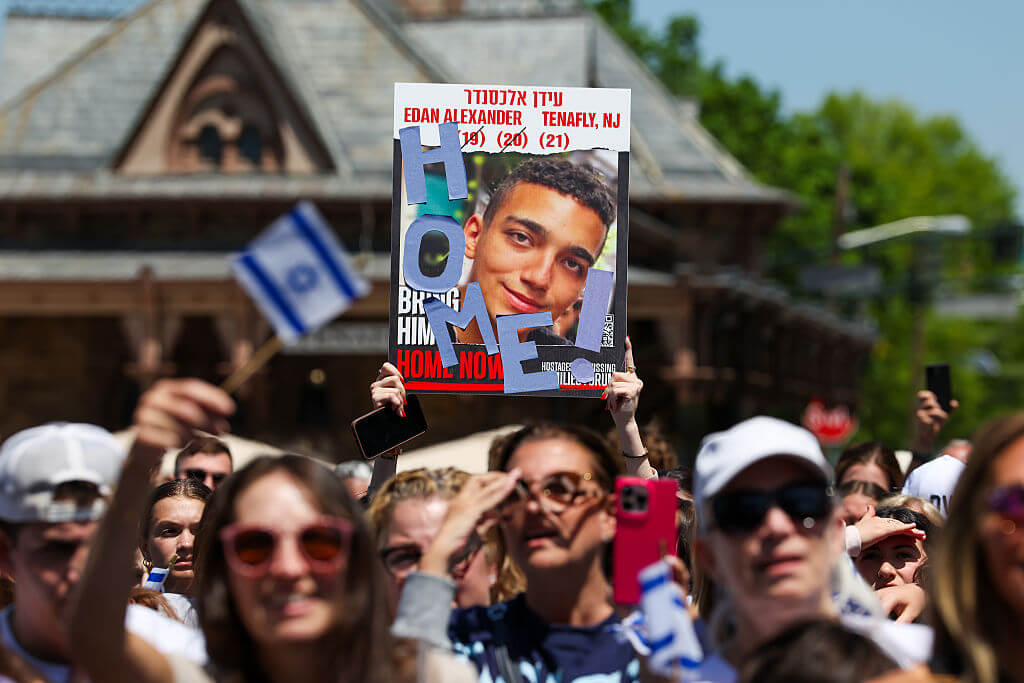Hanukkah’s early start this year put a Siberian tradition on thin ice

Rabbi Levy Kaminetsky, bottom right, prepares to light a Hanukkah menorah made of ice outside his synagogue in Tomsk, Russia on Nov. 28, 2021. (Courtesy Levy Kaminetsky)
(JTA) — The ice menorah of Tomsk has become something of a Hanukkah tradition in that Russian city in Siberia, situated about 2,000 miles east of Moscow.
At 10 feet tall and featuring LED lights incorporated into the branches, it shines in the yard of the city’s Chabad synagogue and is seen as a Jewish addition to the annual Tomsk Ice Park exhibition, whose giant ice sculptures attract thousands of tourists to the city annually.
But Hanukkah came early this year, which was an unusually warm one, jeopardizing the decade-long tradition started here by Levy Kaminetsky, the energetic Chabad emissary who moved with his wife, Gitty, to Tomsk in 2004 from Israel.
“We were watching the thermometer every day,” Kaminetsky told the Jewish Telegraphic Agency.
Eventually, and after some compromises to aesthetics, the ice menorah was sculpted, erected and used for the first candle of Hanukkah Sunday. It is currently the only ice menorah in the Old World, as other Siberian Jewish communities were not able to erect their own ice menorah as they have done in previous years.
The couple realized they might have a problem during Sukkot, in late September.
“Unlike in previous years, it didn’t snow this year during Sukkot,” said Kaminetsky. He said that he believed that this year has been the warmest winter in a long time in Tomsk, and that it could be — as nearly all scientists agree — the result of climate change. The average temperature in Western Siberia is on the rise, scientists there have documented.
Had Hanukkah come this year in mid-December, as it did last year, then the ice would have certainly been safe enough in Tomsk. The mercury never rises past 12°F during that month. But with the holiday, which is determined by the Hebrew lunar calendar, occurring two weeks earlier, “it was really touch and go,” Kaminetsky said.
The main complication was in obtaining the ice, which needs to come from a frozen lake.
“You can cut out the ice only after a few days that the temperature is 14°F or below, otherwise the ice on the lake is not safe enough for the workers extracting the block for the menorah,” he said.
Fortunately, the temperature dipped just in time. A block weighing several tons was carved out by a professional team and trucked over to the synagogue’s yard, where a sculptor quickly shaped it into the nine-branched menorah. But the ice was too soft for drilling, so the artist was not able this year to install lighting in the frame of the menorah.
The Kaminetskys are not disappointed, though. They fitted the menorah with lamps for a candle-lighting celebration Sunday in toasty conditions: It was almost 16°F.
—
The post Hanukkah’s early start this year put a Siberian tradition on thin ice appeared first on Jewish Telegraphic Agency.
The Forward is free to read, but it isn’t free to produce

I hope you appreciated this article. Before you go, I’d like to ask you to please support the Forward.
Now more than ever, American Jews need independent news they can trust, with reporting driven by truth, not ideology. We serve you, not any ideological agenda.
At a time when other newsrooms are closing or cutting back, the Forward has removed its paywall and invested additional resources to report on the ground from Israel and around the U.S. on the impact of the war, rising antisemitism and polarized discourse.
This is a great time to support independent Jewish journalism you rely on. Make a gift today!
— Rachel Fishman Feddersen, Publisher and CEO
Support our mission to tell the Jewish story fully and fairly.
Most Popular
- 1

Fast Forward Ye debuts ‘Heil Hitler’ music video that includes a sample of a Hitler speech
- 2

Opinion It looks like Israel totally underestimated Trump
- 3

Culture Is Pope Leo Jewish? Ask his distant cousins — like me
- 4

Fast Forward Student suspended for ‘F— the Jews’ video defends himself on antisemitic podcast
In Case You Missed It
-

Fast Forward For the first time since Henry VIII created the role, a Jew will helm Hebrew studies at Cambridge
-

Fast Forward Argentine Supreme Court discovers over 80 boxes of forgotten Nazi documents
-

News In Edan Alexander’s hometown in New Jersey, months of fear and anguish give way to joy and relief
-

Fast Forward What’s next for suspended student who posted ‘F— the Jews’ video? An alt-right media tour
-
Shop the Forward Store
100% of profits support our journalism
Republish This Story
Please read before republishing
We’re happy to make this story available to republish for free, unless it originated with JTA, Haaretz or another publication (as indicated on the article) and as long as you follow our guidelines.
You must comply with the following:
- Credit the Forward
- Retain our pixel
- Preserve our canonical link in Google search
- Add a noindex tag in Google search
See our full guidelines for more information, and this guide for detail about canonical URLs.
To republish, copy the HTML by clicking on the yellow button to the right; it includes our tracking pixel, all paragraph styles and hyperlinks, the author byline and credit to the Forward. It does not include images; to avoid copyright violations, you must add them manually, following our guidelines. Please email us at [email protected], subject line “republish,” with any questions or to let us know what stories you’re picking up.












